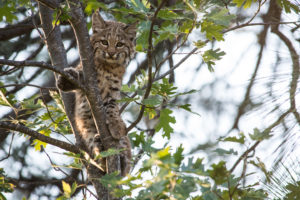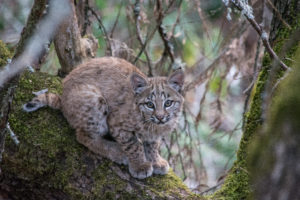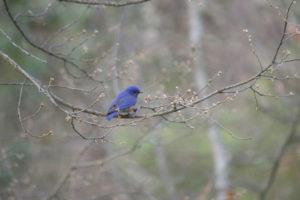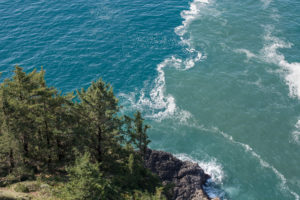by aramatzne@gmail.com | 3 Sep 2018 | Musing
Then
Cooper Island seems a lifetime ago, the light, the endless bird calls, the sand, the cold and eternal, infernal wind. They are far away now. I returned to Cooper the following summer for a shorter stay, and after demanding a wall tent in which I could stand up and be out of the wind simultaneously. By then George met Darcy Frey and the momentum of Cooper drastically increased as Darcy visited the island, interviewing George and me; later Joe McNally came to photograph Cooper and its residents, avian and otherwise. The story was published in the New York Times Sunday Magazine, George Divoky’s Planet, in 2002. Climate change was under debate (yes, even then and even still) and George’s 30-year data set was a prime source of intrigue. The birds George studied definitively returned to their mutual island almost two weeks earlier than when he began summering, and I use the term loosely, on Cooper Island.
Black Guillemots are cavity nesters; when the winter’s snow and ice retreat sufficiently to allow birds to enter their cavities, make it cozy, and spend time, well, nesting, they return. First, there are some flybys, birds stay in the air, doing visual reconnaissance; how much snow is there on their chosen sand spit? Are the nest sites visible? Flybys become fleeting landings, a strut or two along the ground or a momentary claiming of the nest box, snow preventing entering but exposure allowing dibs, if you will. Finally, birds arrive in droves, the mating rituals begin, and the birds settle into family life, breeding, eggs, chicks, frenetic but fleeting teenage days, and fledging. All racing against the spin of the Arctic seasons that until recently favored the dark, cold months.
As the climate continues to change and shift in ways we mere mortals can only guess, the birds long ago began to play the odds, returning earlier with the expectation that their summer homes will be open and inviting earlier this year than last. And, of course, we, mere mortals, are responsible for the Guillemots’ extended summering. Argue what you like, the world is changing and the creatures we so readily dismiss as animals are way ahead of us in understanding and appreciating the implications. They may not discuss it in political terms or devise computer models to help predict their future, but they recognize the current, if limited, advantage or disadvantage that it presents.
As Guillemots nest earlier each decade, polar bears are forced off the ice as it disintegrates beneath them. Traditionally following the ice north through summer, bears are left swimming farther than possible or are forced to be land-bound through summer. Their lives are made by the heavy winter cold and the extensive pack ice on which they travel and hunt. The small gain for guillemots is an enormous loss for polar bears. And, yes, polar bears are a more charismatic species receiving more attention, but, of course, the world is a poorer place for the loss of any species.
While being able to nest a few weeks early appears beneficial on the surface, the reality is Guillemots feed along the ice pack edge. As eggs are laid, and chicks develop, overworked Guillemot parents repeatedly fly to the pack ice to feed themselves and return to Cooper with one fish at a time for their growing young. When the pack ice is near, this equals fat and happy chicks with plenty of Arctic cod to help them grow toward fledging. As the pack recedes from shore and the distance increases, chicks feed less often; parents burn more of their strength commuting and are sometimes required to shift to less desirable forage fish. The location of the ice can change many times through a season; but as the overall size of the pack decreases, the time it is within range of the breeding colony can also decrease.
Now
At times in the past, pack ice was sometimes far offshore and the colony had a dismal showing for the summer’s work. But Guillemots are long-lived birds and the following year provided new opportunities. Now, pack ice consistently does not form as early, nor stay as late. It is not as thick; it retreats farther from shore. It breaks up earlier and provides a less cohesive mass. Being far offshore is the norm, rather than the exception. All of this potentially leads to reduced fitness and productivity.
Where am I going with this? These small threads simply laid out here are the tiniest fraction of all the pieces that fit together to make our world what it is. The intricacy of connections, circumstances, and continuity is, with all of our advanced science and knowledge, still mostly guessed. Each discovery is accompanied by dozens of questions. For all of our bluster and arrogance, we are repeatedly humbled by findings that take us to new places and show us the error of our previous certainties (think blood-letting, asbestos, and nuclear weapons).
To tie some of these threads together for myself, I am embarking on a residency to Svalbard, a Norwegian territory east of Greenland and above the Arctic Circle. Relative to Cooper, many things are different: it is an archipelago, it will be autumn, it will be dark most of the day, and colder than Cooper in summer, the chaotic summer life will have moved south by the time I arrive. The world and I are 18 years older. I see this as the next phase in the Cooper process, a progression of seasons being redefined as we live them.
As I was writing this, I briefly lost the post in the ether; saving the draft returned a blank page. After much swearing, and an impossible attempt to string the ones and zeros of my words together again, I found the draft invisibly saved in the blog menu. Now, this occurrence neatly ties my thoughts together.
What do we know of the fabric of the Arctic? What do we know of things lost and what can we surmise from the departed? What happens when the richly wrought landscape becomes a blank page? There is no backup menu or replacement post. It is there, or it is not. Much like the lost post, how the threads unravel and disintegrate into the void, is unknown. What we do know is that stringing new ones and zeros together in a way that resembles the original is impossible.
I would be delighted to have you join me virtually for the trip to Svalbard. There is much to be learned and explored. There is much more to the natural world than ones and zeros.
by aramatzne@gmail.com | 20 Aug 2018 | Musing
Part 25, summer winding down
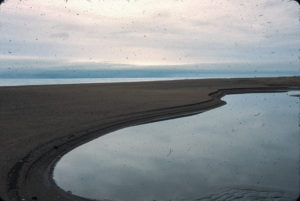
Calm on Cooper.
22 Aug
George didn’t make radio call this morning but called Dave yesterday and said he didn’t think it was going to work to get me off the island by the first. I was pretty distraught. I am thoroughly tired and cold. I was mean to a bird who was being uncooperative and then was ashamed of myself. I pulled it together for another call at 1315 – George was more positive and thought I could be back in Barrow in time to make my original flight on the 30th.
I am now wearing both sets of long underwear, two bottoms, and two tops as well as two pairs of socks. There was snow on the ground this morning and squalls moved through all day. The thermometer stopped working and I’m a little bit glad that I don’t know the temperature. I am looking forward to being warm and dry on a regular basis.
The colony is quiet – the terns and Sabine’s are gone. Even the phalaropes disappeared today. The Black Guillemots are subdued – no one fledged yet but my down and feather collection duties are rapidly dwindling. Soon it will just be measure and weigh, weigh and measure. I think tomorrow is the last day for down. George said rarely do chicks stay past a wing length of 140 mm and there are several in the high 130s already. I wonder if it is just the residual storm effect that keeps them here?
I walked some tonight, but other than nest check mostly stayed in the tents. I read a bunch of essays in the Birder’s Handbook (why haven’t I been reading them more through the summer?!), read WildEarth, and On the Road by Jack Kerouac – not quite done with it yet but getting there. Now there is lots of good reading time. It’s too cold and quiet to walk so much. And my knees are beaten.
23 Aug
Silent, windless, calm day. How wonderful! There was a long, light snow this morning – very fine but enough to dust everything white. And no wind, not a breath. The lagoon was a flat mirror. The ocean was barely flowing, that gentle, smooth undulation of incipient waves rolling through water too dense to respond to weak pushes. The superior images made everything dreamy, and that incredibly precise, sharp quality to the air returned so that I could see ducks on the water all the way across the lagoon to the bluffs and their images on the ocean horizon.
There were long lines of eiders hurrying in single file – double rows of them – the actual flock and the image above. Weaving, opening, and closing the gaps between sky and water, the wave of motion moving through the lines in mirror images from front to back. Always just at the edge of the horizon, often defining the line between sky and water. As Craig said the other day, “That’s the Arctic.” The eiders define it all so well. What better symbol of the fecundity, the mobility, the vitality of the Arctic than that ever-flowing single file of eiders in August?
The snow buntings are fun. They have been flitting around the camp in great hordes the last week or so, 15 to 25 of them, fluffy, puffy, downy, white flashes of vibrant spirit. They wake me in the morning, calling, singing, standing on the tent over my head and chirping, fighting, and chasing each other around and about. They make me smile every time I see them. I enjoy their company and their perkiness.
It was silent today. Two or three planes. That’s it. Several boats went by on the flat waters, but I couldn’t hear them. My crunching steps and breathing were the only breaks in the stillness. The passing snow flurries that went through this afternoon dampened everything that much more.
I found a dead guillemot today, all that was left was the head, wings, and feet. The rest was stripped to the bone. The keel, spine, and rib cage were laid out, bare and red from the rented flesh. The white patches on the wings were tinged with pink. Even the tongue had been pulled inside through the head and left hanging out the back of the skull. Amazing the efficiency with which the eater stripped it. I am assuming it was a peregrine but don’t know for sure. I didn’t see marks on the keel that indicate a raptor kill, but I don’t know what to look for either so…
25 Aug
The past few days have been utterly still and calm, gray and cloudy with passing flurries and showers but little wind. I’m suspicious of this newfound and continuing calm. I think it is holding out for next week to let us have it. I’ve been too tired to enjoy it, too, unfortunately. Yesterday I walked for a short while down on the tundra, but mostly I’ve read in the cook tent or the sleep tent. I sat outside for several hours this afternoon and read there, too, until I was too cold. I finished Jack Kerouac’s On the Road last night. Good read. Read the Pilot’s Wife today. Not a classic but spellbinding, in its way. I read about four pages last night and then the rest of the book this afternoon.
The island is quiet. Few birds are left, dunlin and turnstones. No terns, no Xena, almost no glaucous gulls. The Jaegers persist. The puffins circle.
I broke a chick’s wing the other day. I was so tired and angry and frustrated – the end of the field season exhaustion rising to set me off with one chick too many squirming, fighting, shitting, and evading me. I vividly remember what happened although I didn’t realize at the time what I did. It was the chick I said I had been mean to, was ashamed about. It kept squirming and squawking and fighting and I held it hard against my body to get it to settle down, hoping it would realize struggling was useless. Its wing must have already been at a bad angle and pushing it up against my body made it snap. I felt awful when I saw it the next day, but it wasn’t until a couple of days later that I connected all of the pieces and realized it had been my actions which caused this. Its wings are still strong, and it seems to be growing pretty well; I’ll wait until George gets here and decide what to do about it. If it is young enough and early enough in the growth stage perhaps it will mend and be able to fly. If not, perhaps George can take it back to the Seward SeaLife Center. I can’t believe how foolish I am. That day I kept trying to tell myself that it wasn’t their fault. They were just afraid and wary of me, and I should be more sympathetic, but the other side kept saying we go through this every day, don’t they get it? If they cooperate, I’m done in 20 seconds if I have to chase them and they resist it’s much harder on both of us. Alas, it wasn’t until I held that little bird against me so hard that I knew I had lost it and had to get control of myself. I can’t remember if I took a break right away or not – I certainly should have – I was ashamed. I didn’t realize, however, how much damage I did. I think I would not have felt so terrible if I had dropped one of these heavy nest sites on a little chick – at least it would have been quick and done, not lingering around with an uncertain fate.
Two more chicks fledged last night. That’s five gone. They are all going to stay 40 days. I’m sure of it. Some of them are large – long wing chords if not high weight. I keep thinking that if the food stocks are going to crash, then the chicks that are large enough should go and seek their fortunes rather than depend on parents that are not providing enough. But how do you tell this to a guillemot chick? As each of the data columns for the older ones reaches the bottom of the page in the databook, I tell them it’s time to leave because I’m out of room for them in my book. They’re not listening.
by aramatzne@gmail.com | 22 Apr 2018 | Musing
Part 9.
The Black Guillemots are back, bobbing their heads, and claiming their nest boxes. A cavity-nesting bird of Arctic waters, they traditionally did not nest so far north in Alaska, one reason was a lack of natural cavities more readily found in rocky cliffs farther south. A U.S. military site abandoned in the 1950s, Cooper Island, was left littered with debris – 55-gallon drums, plywood, and scrap metal. The Guillemots suddenly had nest cavities on an island nearer the pack ice where they feed. Cooper Island is about 9 feet high at its highest point, composed of sand and gravel; it disappears into the pack ice for the winter. As the island and its nest cavity debris emerge in the spring thaw, the birds return, find their mates and their previous nesting box, and start all over again.
George, the force behind this research – for more than 40 years – mapped the location of each cavity, banded the birds nesting at each site, and kept track of the schedule, arrival and departure dates, relationships, eggs, and chicks each summer. The massive data set that he is accumulating shows a shift in when birds arrive on the island, how early cavities become snow-free allowing birds to enter and begin their mating rituals, how many chicks fledge relative to the location of the pack ice. He has followed a world of questions and shifting answers about bird phenology, climate change, and the Arctic systems.
I stepped into this story only briefly, but 18 years later the impact has yet to wear off.
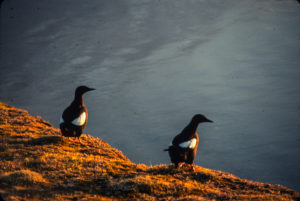
Black Guillemots in the midnight sun
10 June
The birds were back yesterday. They seem to be roosting randomly but have begun to claim boxes and squabble. I try to ID them, and some of my attempts are right – meaning the pairs as I identify them align with the claimed nest boxes as George previously determined.
George usually fills garbage bags with snow as a water supply for later in the summer, I did a few but they tipped and leaked, and I’m not terribly excited about drinking water out of garbage bags. Instead, I built a box in the sand, dug out the center, lined it with the tarp and garbage bags and filled it with snow yesterday. I don’t know if the tarp will hold water but the snow will last longer and I can melt it as I need it. If it doesn’t work so, I spent a few hours of labor.
It is still gray and grim out there. Since the fog came in the other day, it hasn’t left again. I couldn’t see across the island yesterday, and most of the time when I was checking boxes I couldn’t see the tent – only 200 yards visibility. Today it seems cloudy, the ice and sky are one again, though a lot of the land is clear.
The Guillemots are still circling, I hear them go over the tent – they sound like hovercraft in SciFi movies. I’ve been dragging out of bed each morning. My alarm goes off at midnight, and I get up at 0100 or 0130 or 0200. The birds got me up this morning. I kept dropping back into sleep and dreams, but I heard the hovercraft noise and was awake. They haven’t settled yet for the morning, so I am having breakfast and tea.
I saw the first American golden plovers today. Two of them flew over Pasta Pond – so named because it is not as salty as the ocean but not fresh water, either – it is the perfect salinity for cooking pasta. Beautiful birds. The ice is thawing quickly, and there is a deep layer of water on the surface, did the ice sink? Or was the pond frozen all the way to the bottom and now the thawing surface is forming a puddle on top?
This morning I watched an Arctic tern for a while. What a magnificent bird. As wolves are described as loping through a meadow, the Arctic tern is the loper of the bird world. The wings are so long and narrow with that elegant upper edge of black to the primaries. They slide through the air, very nonchalant and casual. Nowhere to go, all day to get there. When they pause to hover they open their long forked tails and the delicate feathers in the middle seem translucent, and perfectly, evenly, rounded out to the long outer feathers that stream behind them. When the tail is closed they are a streamlined bomb with a tail shaft. Watching one dive the other day it would lope along, tuck and hover, look, tuck and hover. Pulling up each time it dropped to have a better look and then wandering along as whatever it targeted disappeared.
This afternoon there were five terns, screaming, raucous creatures. Wheeling, spinning, turning and chasing one another, constantly talking. The clouds were so low that they would chase around, chattering and plainly in view and then they would be enveloped by the gray, dense air, their cries muted. They would reappear a few minutes later, out of thin air, as it were. Just there, the black trailing edge sharp and crisp, the rest of the bird hiding among the clouds.
There are now Sabine’s gulls floating around as well. They, too, are beautiful, elegant birds. A full black head, gray secondaries, and black primaries, the underwing white. They fly somewhat like a tern and have a forked tail, though not nearly so forked as the terns’. Graceful flyers, not lopers or speeders or trick fliers, just pleasing to watch.
And the Pomarine Jaegers are fabulous. I keep coming back to them. They fly somewhat like a tern though are much larger and their wings much longer. They are always silent. Sometimes alone, sometimes in groups of 6 or 7, always silent. I see them winging toward me, they materialize and pass by, uninterested in the doings of mortal beings.
The owl came to see me again this morning. I was brushing my teeth, looked up and there was the owl coming straight at me. Again it came within 15’ or 20’, looked right at me, turned on its wing and glided another 50’ before landing. It preened some, watched me, and then took once again to the wing.
There were a few flocks of long-tailed ducks, Brant, snow geese, and eiders. There are tons of Northern Pintails, another beautiful, graceful bird.
11 June
It’s foggy and thick again this morning. Now and then the sun works hard at break through. Relatively no wind, which is fabulous. I suppose as it warms up though it will begin again in earnest.
I had another owl encounter today. I walked the length of the colony and was walking along North beach. The ice is retreating, and I am finding a lot of beach hidden beneath it. I was looking across the ice, I turned to look west, and the owl was coming toward me. Again it landed on a perch 100’ away. It sat and watched, preened, fluffed, watched. I watched it and the other birds moving behind it. After several minutes it dropped low off the perch and winged straight to me. This time at eye level, straight into my binoculars, I could see its amber eyes and the golden flecks of light they emitted. The feathers around the eyes, the disk, the edges of the wings. I dropped my binocs when he filled the frame. It went right over my head no more than 10’ above me. I turned, watched him pulled up short, hover ½ a second and then glide away through the waves of moisture rising off the ice pack and sand. Am I such an oddity to them?
In the belief of many native peoples, the owl is a sign of death and deception. Are they warning me of something? Or just carrying a message of someone else’s demise? Perhaps they are trying to make me see that I am only deceiving myself with this path and life I have chosen. I have so many questions and doubts about myself that it is impossible sometimes for me to know what I am doing. Sometimes I think I have an idea, but I still wonder how I do the things I do.
13 June
I was watching the guillemots yesterday, a pair, they were head bobbing and touching bills and then would sit close to each other. The female would sometimes flatten herself to the ground, lower her neck and head and then raise her bill and cry – Here I am, let’s have at it. It made me think about how simple life would be if humans could do a little head bobbing, some bill touching, and then fornicate. Afterward, they could go back to their respective nest boxes with no one paying any attention to who had been where or what they had been doing. I think I can manage that whole head-bobbing thing.
Now, I think I must turn in for the afternoon; it is 3:00 after all. It has been warmer when I first get up, but that 0400 to 0700 shift is brutal. It is cold. If there is no sun or if there is any wind it sucks every ounce of heat out of you. Brrrrrrrrrr.
14 June
Well, my plan yesterday failed. The idea was to go to bed earlier, so I would get up closer to midnight when I’m supposed to start the morning bird rounds. So, I went to bed at about 3:15-ish. I slept through my alarm at 11:00, woke with a start from a dream at 11:43. Instantly fell back to sleep. Woke again at 12:30 and then again at 1:44 and finally got up at about 2:00. Good plan, huh? 11 hours of sleep. Guess I was tired.
Had a good morning, there was, mercifully, no wind. I did the requisite rounds, figured out the pairs and boxes. Radioed in and found out George wasn’t coming in (not surprised) and decided to give the birds the rest of the morning off. I had already been hassling them for 4 hours; they needed quality time with their mates.
I went for a walk.
All the way to the barge at the far east end. I don’t know how far it is, a few miles maybe, all sand and gravel. For a long way, the island is only a few hundred feet wide at most. The tundra is beautiful. The willows are blooming. There are a lot of meltwater ponds and birds of all forms. I collected three dead ones – two king eiders, one common eider. They are so beautiful, and their feathers are intensely dense and soft. I tried to sketch the common eider – eek. The head was the only part I liked. After a night of thick fog, it was beautiful, clear, and sunny for my walk. When I reached the farthest point, at the barge, the fog rolled in again.
I headed back, nowhere to go, all day to get there. I found two intervertebral discs from whales and, of course, lots of good stones – of which I collected many.
I walked along the south shore of the tundra. The brant have begun to lay eggs and were chasing each other and squawking as I approached. I found four red phalaropes feeding in a pond. Most of the birds pay no attention to me when I have only my binocs or as long as I don’t see them right off. I about stepped on a semi-palmated sandpiper, and it didn’t even hardly move. If I have the camera in hand, the birds are gone 100 yds in advance of me.
I walked away from the phalaropes stepping across a narrow channel that connected two large ponds. As I put my foot down at the edge of the channel this thought went through my head, “Is that a bear track?” Sure enough. I stepped back and looked around for more tracks. The track I stepped in – the largest bear track I’ve ever seen – was the cub. Mama’s print was as wide as my foot is long and about the overall size of a dinner plate. Big Bear. That changed my perspective on the possibility of seeing one. Of course, I would still love to see one, but maybe with some space between us. The tracks weren’t fresh, but I find it hard to believe prints, two sets no less, could have survived the winter, so, perhaps a few weeks? How much was open when I got here? Was that channel thawed already? There was a huge chunk of ice still in the channel – substantial enough for me to walk across… did the tracks survive the winter or did I have visitors recently? It has been so foggy, they could have walked past my doorstep, and I wouldn’t have known. Like the tundra swans on the pond yesterday. They appeared in the fog and just as mysteriously disappeared in the fog. I spent a lot more time looking around after that. Not surprisingly. Don’t want to startle a bear the size of a VW bug, especially if it’s with a youngster. No, that’s not a good idea.
George did not return today. The plan is that he will be in Barrow tomorrow and will find some way to get here on Friday. I’ll believe it when I see it. I suspected from the start that his idea of dates was a fuzzy one.
Dave didn’t have any products for me to guess today. I got him instead to teach me some Inupiaq words. I like them a lot. They sound real – not arbitrary sounds that form words but more like sounds that are things. And I like the way words are combined to create place names like Anaqtutuvuq – the pass where caribou leave their waste – more or less. An’noogaluk
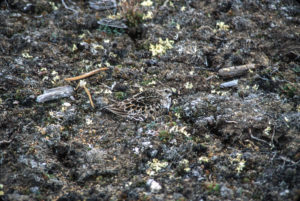
Tundra sandpiper
Join me this fall on The Road not Taken Enough when I go to Svalbard on an Arctic Circle residency Artistry in the Arctic.


